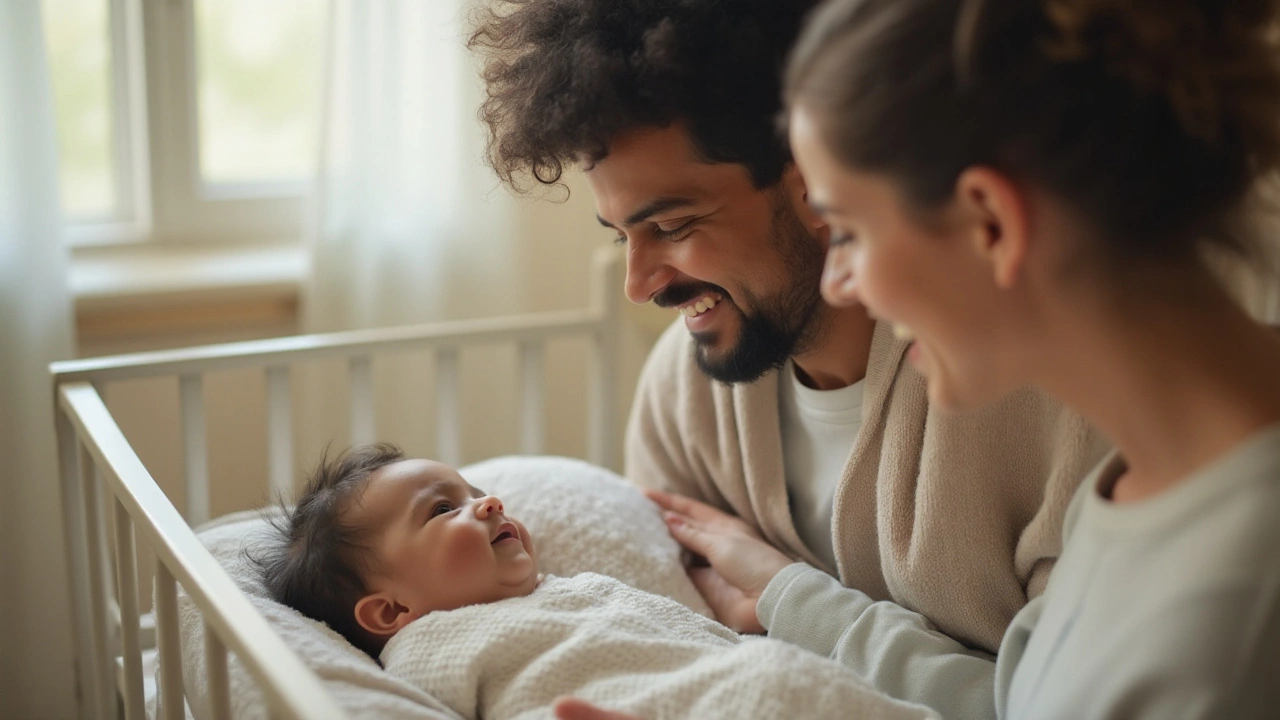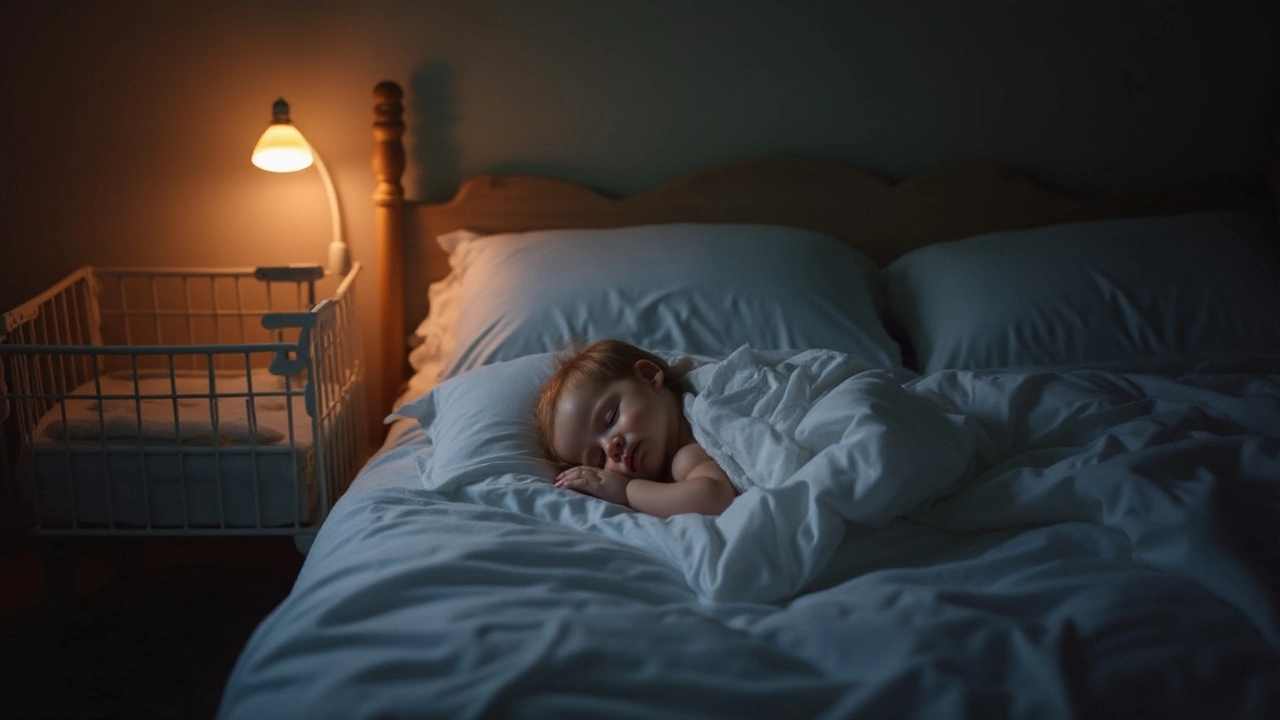Understanding When SIDS Concerns Fade: A Baby Blanket Guide

Ensuring the safety of your little one while they sleep is a big concern for most parents, especially when hearing about Sudden Infant Death Syndrome (SIDS). The worry often peaks when the baby is very young, but there's reassuring news as your child grows. Knowing when they can sleep soundly with minimal risk is empowering for any parent.
With age, the threat of SIDS declines, mostly after six months, and it's crucial to understand how the sleep environment, like the use of baby blankets, plays a role. By learning about appropriate sleep practices and creating a safe sleep space, parents can significantly reduce risks and focus more on cherishing these early moments instead of worrying.
- Understanding SIDS: What Parents Need to Know
- Key Milestones: When SIDS Risk Decreases
- Safe Sleep Environment: Baby Blankets and More
- Tips for Peace of Mind: Ensuring Safe Sleep Practices
Understanding SIDS: What Parents Need to Know
Sudden Infant Death Syndrome, often referred to as SIDS, is a term that understandably causes anxiety for new parents. It refers to the sudden and unexplained death of an otherwise healthy baby, usually occurring during sleep. This phenomenon typically affects infants between one month and one year of age, with the highest risk period being from two to four months old. Understanding what SIDS is and the factors associated with it can help demystify some of the fear and arm parents with knowledge to protect their child.
The exact cause of SIDS isn't known, but experts suggest it may be related to problems in the portion of an infant's brain that controls breathing and arousal from sleep. This is why creating a safe sleep space is essential. Strategies to mitigate the risk include placing the baby on their back to sleep, using a firm mattress without loose bedding, and keeping the sleep area free from toys and plush items. The widespread adoption of these practices has significantly reduced the instances of SIDS over the years.
“In the United States, SIDS rates have declined by 50% since the 'Back to Sleep' campaign was introduced in 1994,” states the American Academy of Pediatrics. This important milestone highlights how critical sleep positioning and environment modifications are in safeguarding infants.
While the term itself is daunting, knowing the factors that can increase a baby's risk can guide preventive actions. These include prenatal exposure to tobacco smoke, premature birth, or a family history of SIDS. The practice of room-sharing without bed-sharing is another suggested preventive measure, allowing caregivers to monitor their child's safety during sleep while minimizing associated risks. Data has shown that babies who sleep in the same room as their parents, but on a separate surface, have a lower risk of SIDS than those who sleep separately from their caregivers.
Another vital tip for parents is to maintain a comfortable room temperature to prevent overheating, which is considered a SIDS risk factor. The general guideline is to dress your baby in just one more layer than you would wear yourself. Consider ditching blankets altogether in favor of wearing a sleep sack, which can provide warmth without the risk of covering the infant's face. While baby blankets can be beautiful and cozy, they should only be used when the risk of SIDS diminishes, typically after the baby reaches their first birthday.
Finally, offering a pacifier at nap time or bedtime can also help reduce the risk of SIDS, though the mechanism by which it does isn't entirely clear. Some theories suggest it enhances protective reflexes or simply keeps the airway open by promoting suckling. As always, consult your pediatrician before introducing new elements into your baby's sleep routine to ensure they're suitable for your child’s specific needs.

Key Milestones: When SIDS Risk Decreases
The journey of a new parent is peppered with worries and hopes, and among these, the risk of Sudden Infant Death Syndrome (SIDS) often looms large in the initial months. Understanding specific milestones that indicate a decrease in SIDS risk can substantially comfort any caregiver’s heart. Research indicates that the majority of SIDS cases occur before six months of age, with the peak between two and four months. This initial period is critical, as infants' sleeping habits and environments play a significant role in their safety. After the six-month mark, the risk drastically diminishes, offering a breath of relief to many.
By the time most infants reach one year, the likelihood of SIDS becomes exceedingly rare. At this age, babies have more control over their head and neck movements, and they can roll over, which decreases the risk of suffocation during sleep. This enhanced motor skill development is crucial for their ability to respond to and mitigate immediate threats, such as repositioning themselves if their breathing is obstructed by a blanket or a plush toy. Even though the risk decreases, experts still recommend that babies sleep on their backs until their first birthday to maintain consistency in safe sleep practices.
It's important to also consider the environmental milestones that coincide with your baby's development. Creating a safe sleep environment that reduces SIDS risk includes keeping the crib free from any soft toys, loose bedding, and pillows. For baby blankets, it's vital to ensure they are breathable and not too heavy, allowing your little one to have a safe and peaceful sleep. "The consistent use of safe sleep practices, coupled with developmental progress, plays a significant role in mitigating SIDS risk," Dr. Joanne O'Brien, a leading pediatric sleep specialist, remarks.
Parents should always be vigilant about the baby’s sleeping environment. While milestones in physical growth are crucial, seasonal changes, such as colder months, might influence the need for additional blankets. In such cases, sleep sacks can be a safer alternative, keeping your baby comfortably warm without the risk of suffocation. Additionally, maintaining a cool, smoke-free room environment contributes to reducing SIDS risk. Equipping yourself with a baby monitor can also provide peace of mind, especially when allowing more independence as they grow older.
Determining when to start relaxing these precautions can depend heavily on your child’s individual progress. Some babies achieve physical milestones faster than others, while some may lag, needing extended caution. A unique aspect of parenting is tuning in to your child's specific needs and developments. Regular pediatric check-ups can offer personalized guidance and ease concerns, tailoring safety recommendations to align precisely with your little one’s growth timeline. Embrace these milestones as a journey, one that celebrates both newfound parental confidence and your baby's incredible growth.

Safe Sleep Environment: Baby Blankets and More
In the hazy, sleep-deprived days of early parenthood, setting up a safe sleep environment for your infant can sometimes feel daunting. With the risk of SIDS consuming much of the parental mindshare, finding the right practices can be both confusing and critical. One of the most comforting yet trickiest aspects is the use of baby blankets. Blankets, after all, have been historically seen as symbols of warmth and security. Yet, for infants, particularly newborns and those under a year old, they can pose risks if not used with caution.
Let us delve into the essentials of creating a safe sleep setting. First and foremost, experts recommend that the baby sleeps on their back on a firm mattress with a fitted sheet, and without any loose bedding. The challenge lies in keeping the infant warm without adding too much in the crib. A common question is: when are blankets safe? The general recommendation is to avoid loose blankets until the baby turns at least a year old. Instead, consider using sleep sacks or wearable blankets designed specifically for infants, which provide warmth without the risk of covering the baby's face.
"The safest way to put an infant to sleep is on their back, in a bare crib," advises the American Academy of Pediatrics.
In addition to blankets, let's consider other elements in the crib. Keep it simple and devoid of toys, pillows, and bumpers. It may appear minimalistic, but simplicity is key to reducing risks. This doesn't mean the sleep environment can't be cozy; the goal is to achieve coziness through constraints that keep your baby safe. Introduce your baby to swaddling, an age-old practice that helps the newborn feel secure and can even promote better sleep. As they grow stronger and begin to roll over, transitioning from swaddles to sleep sacks can offer similar snugness without restraint.
One size doesn't fit all when it comes to sleep sacks. Options abound, with various weights and styles to suit different climates and baby preferences. Ensure the sleep sack fits well — not too loose or restrictive — allowing enough room for leg movement while keeping the infant snug. Beyond blankets, room temperature plays a noteworthy role in infant sleep safety. Keep the room at a comfortable level, between 68°F and 72°F (20°C to 22°C), to prevent overheating, a known risk factor for SIDS. Many families use a fan to keep the air circulating, which can also help with temperature regulation.
This comprehensive approach places emphasis on informed decisions made from a combination of expert recommendations and parental instincts. Parents need to feel empowered to adjust as their baby grows and develops, continuously refining what works to ensure safety and comfort. While it might seem tempting to deck out the crib with fluffy, adorable accessories, remembering the fundamental aim — a safe sleeping environment — is vital. Redirect those decoration desires to other areas in the nursery where they won't interfere with safety.

Tips for Peace of Mind: Ensuring Safe Sleep Practices
Creating a safe sleep environment for your baby is one of the simplest and most effective ways to reduce the risk of SIDS. It’s a mix of science, common sense, and a bit of practical innovation. Adhering to these principles not only eases your worries as a parent but also ensures sweet and sound slumber for your baby. Let's delve into some tried and tested tips to help you feel confident about your choices.
One fundamental tip is to always place your infant on their back when putting them down to sleep. This simple position greatly reduces the risks associated with SIDS. Since the American Academy of Pediatrics recommended back sleeping in 1992, rates of SIDS have dropped by more than 50%. Another key factor is creating a smoke-free environment, both in your home and car. Exposure to secondhand smoke significantly increases the risk of SIDS, and eliminating this exposure can make a substantial difference.
While it might seem comforting to cover your baby with a soft, snuggly blanket, it's vital to ensure it’s done safely. Consider using a well-fitted infant sleep sack instead, which can provide warmth without the risks associated with loose bedding. If blankets are used, they should be lightweight, tucked securely around the mattress, and should only reach up to the baby's chest, leaving their head uncovered. This practice minimizes the chance of suffocation while keeping your little one cozy.
“Parents who follow safe sleep practices, such as back-sleeping and using a firm sleep surface, are taking important steps to reduce their baby’s risk of SIDS,” says Dr. Rachel Moon, a leading pediatrician in sleep safety research.Moreover, ensuring that the crib is free from clutter is crucial. Stuffed animals, bumper pads, and toys should all be kept out of the crib. They may look adorable, but they can pose serious risks by accidentally covering your baby's face or restricting their movement.
Consider the room temperature and attire for your child. Keeping the room too warm can increase the risk of SIDS. Babies should be dressed appropriately for the room temperature, generally needing no more than one layer more than an adult would wear. Use a fan or crack a window to maintain airflow. This not only aids in temperature regulation but has also been suggested to reduce SIDS risk by enhancing air circulation.
Embrace technology but with a skeptical mind. Although there are numerous gadgets claiming to offer real-time updates on your baby’s well-being, nothing replaces the basics of safe sleep practices. Video monitors and wearable devices can offer peace of mind, but ensure they don’t become a substitute for vigilance. Dependence on technology should not distract from following the recommended guidelines I’ve shared.
Implementing these practices can be life-changing, ensuring that you’re not just placing your baby to sleep, but that you’re setting the stage for sound and safe rest. Armed with this knowledge, nighttimes transform from a period of anxiety to a cherished routine of nurturing and care. Remember, while these measures significantly aid in safety, they also empower you as a parent, providing peace of mind and more cherished nights of calm and quiet.

